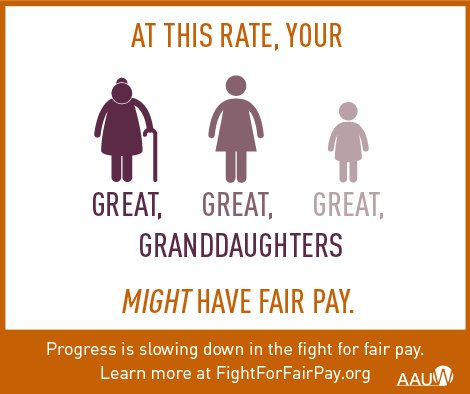By Julie Laut
On Tuesday, April 4, 2017, I will observe Equal Pay Day, a day that symbolizes how far into the new year women must work to earn as much as men did in 2016. According to the latest statistics, women in the United States who work full time year-round earn just 80 cents for every dollar made by men. The gap has closed significantly since the 1980s, when women earned just 60 cents to the dollar, but even at this current pace the American Association of University Women (AAUW) estimates the gender wage gap will not close until 2152. Data from multiple sources shows that hetero-normative white men continue to dominate pay in 98% of job categories, just one way in which the patriarchal nature of our economic structure continues to devalue women’s work and worth within our society. Women cannot wait 135 years to achieve economic parity. We must educate ourselves on the extent of the issue and find ways to take action now, individually and at the state and national levels.
However useful 80 cents to the dollar is as a reference due to its simplicity, that number flattens an extremely complex issue that impacts women throughout the United States in a myriad of ways. A pay gap persists in every state in the country and throughout 98% of occupations, from the best paid (medicine and law) to the least (janitorial work and service jobs). Statistics show that the gender wage gap is smallest at the top of the socio-economic ladder and widens in lower-paid and lower-skilled jobs. Exceptions to the rule include social work, health education, elementary and middle school teachers, and other so-called “pink collar” jobs where wages historically have decreased as women came to dominate the job category. The gender wage gap also increases as women age, a generational gap that tends to undermine women’s unity on this issue.
While the fight for pay equity will continue at all socio-economic levels, closer attention must be paid to the fact that women in low-income occupations, women whose education stopped after high school, and women of color endure the largest pay gaps. According to the AAUW, the pay gap in 2015 was largest for Hispanic and Latina women, who received only 54% of what white men were paid, meaning Equal Pay Day for Latinas does not come until November! Stretched over a lifetime of work, this gap results in earning losses nearing $1,000,000. Similarly, African American women are estimated to lose nearly $900,000 throughout their work lives as a result of unequal pay.
Parenthood also remains a major detriment to equal pay, with working mothers in the lowest income brackets subject to a higher “motherhood penalty” than higher-income earners and women without children. According to research by Michelle Budig, a professor of sociology at the University of Massachusetts, working mothers’ income decreases by 4% with each child, whereas fathers with at least one child reap an average pay increase of 6%. The impact of this wage gap on our communities cannot be underestimated. Nearly one quarter of children in the U.S. are being raised by single mothers, according to U.S. census reports, and nearly half of these families live below the poverty line. Without a dependable living wage, single working mothers struggle to afford basic housing and healthful food for their families, and are forced to rely on substandard childcare.
Organizations such as the American Association of University Women (AAUW) and the National Organization for Women (NOW) have fought for pay equity for decades and continue to bring attention to this persistent discriminatory issue year after year. As a result some progress has been made, especially for upper-middle-class women with college degrees. A 2013 report from the Senate Executive Committee Task Force on Faculty Issues and Concerns at the University of Illinois found that a 6-10% gender pay gap persists on campus across units and faculty ranks, far below the 21-23% national median wage gap. Also, legislative action has been taken to attempt to close the gap. Illinois Governor Pat Quinn signed the Equal Pay Act into law in 2009, which prohibits employers from paying men and women differently for doing the same work, and provides options for filing complaints against discriminatory employers. But the Act clearly has not solved the problem. The AAUW currently ranks Illinois just 24th in the nation in regards to the pay gap. And the problem exists right here in Champaign County where, according to Data USA, a website and visualization engine of public U.S. Government data, the average male salary is approximately $58,500 compared to the average female salary of $48,231, an 18% gap. As recently as 2015, wages for female workers in our area lagged behind males in high-skilled jobs requiring advanced degrees as well as in service industry and manual labor occupations.
So where do we go from here? First, require transparency from employers so that companies and institutions have a harder time denying discriminatory pay practices. We hope that the executive action announced by President Obama in 2016 requiring pay data collection by gender, race, and ethnicity from employers with more than 100 employees will take effect this year as proposed. Second, encourage Congress to update the Equal Pay Act of 1963 to close existing loopholes and “create incentives for employers to follow the law, empower women to negotiate for equal pay, and strengthen federal outreach and enforcement efforts.” Third, work locally to urge our leaders to pass legislation prohibiting employers from utilizing past pay history to determine future pay. Discriminatory pay should not follow an employee from job to job. Fourth, address the “motherhood penalty” through generous parental leave with job protection, subsidized childcare, and options for flexibility in work hours.
And finally, perhaps most importantly, support and encourage women to seek leadership positions. A smaller gender leadership gap will result in a smaller gender pay gap.
Julie Laut, a working mother of two, lives in Urbana


